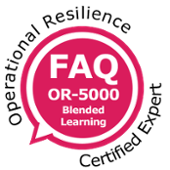Governance and Risk Culture
A robust risk management culture, championed by the Board and senior management, is essential for mitigating operational risks. The RBI guidance emphasizes the importance of establishing clear expectations, ethical standards, and appropriate incentives for risk management. The Board and senior management should lead by example, demonstrating a commitment to sound risk practices. Additionally, robust risk management training should be provided to all levels of the organization to foster a risk-aware culture.
Effective operational risk management requires a well-structured Operational Risk Management Framework (ORMF). This framework should be embedded within the organization, clearly defining roles and responsibilities and outlining processes for identifying, assessing, and mitigating risks. The ORMF should be supported by robust risk reporting and information systems to enable informed decision-making.
Principle 4: Comprehensive Operational Risk Management
The Board of Directors should lead in establishing a solid risk management culture, which Senior Management should implement.
The Board of Directors and Senior Management should establish a corporate culture guided by solid risk management, set standards and incentives for professional and responsible behaviour, and ensure that staff receive appropriate risk management and ethics training.
This section outlines the critical role of governance and risk culture in effective operational risk management.
Board and Senior Management Leadership
The Board and Senior Management are pivotal in establishing a solid risk culture. This involves:
- Setting clear expectations and ethical standards
- Designing appropriate incentive structures
- Ensuring adequate risk management training
- Demonstrating consistent support for operational risk management
Operational Risk Management Framework (ORMF)
The ORMF should be fully integrated into the overall risk management framework. Key components include:
- Clear documentation of governance structures, policies, and procedures
- Defined risk appetite and tolerance levels
- Effective risk identification, assessment, and control mechanisms
- Robust risk reporting and information systems
- Independent review and challenge of risk management processes
The ORMF should be embedded across the organization, with responsibilities clearly defined for the Board, Senior Management, and business units.
Collaboration and Accountability
Effective operational risk management requires collaboration among the three lines of defence:
- The first line of defence. Business units are responsible for identifying and managing operational risks.
- The second line of defence. Independent oversight and challenge of risk management activities.
- The third line of defence. Independent assurance of the ORMF's effectiveness.
By fostering a solid risk culture and implementing a robust ORMF, regulated entities can significantly enhance their resilience to operational risks.
Note: This summary provides a high-level overview of the key points in the guidance note. For a more detailed understanding, please refer to the original document.
More Information About Blended Learning OR-5000 [OR-5] or OR-300 [OR-3]
To learn more about the course and schedule, click the buttons below for the OR-3 Blended Learning OR-300 Operational Resilience Implementer course and the OR-5 Blended Learning OR-5000 Operational Resilience Expert Implementer course.
 |
 |
 |
 |
 |
![[BL-OR] [3-4-5] View Schedule](https://blog.bcm-institute.org/hs-fs/hubfs/hub_generated/resized/e4287b59-1a43-4e10-8e43-c73b27b3ca39.png?width=172&height=50&name=e4287b59-1a43-4e10-8e43-c73b27b3ca39.png) |
![[BL-OR] [3] FAQ OR-300](https://blog.bcm-institute.org/hs-fs/hubfs/hub_generated/resized/294e989f-8613-4bf3-96a5-a89408cfb9ca.png?width=150&height=150&name=294e989f-8613-4bf3-96a5-a89408cfb9ca.png) |
 |
|
|
|
||
 |
 |


![Email to Sales Team [BCM Institute]](https://blog.bcm-institute.org/hs-fs/hubfs/hub_generated/resized/850988ce-aa7d-4953-95cf-797635341edd.png?width=100&height=100&name=850988ce-aa7d-4953-95cf-797635341edd.png)


